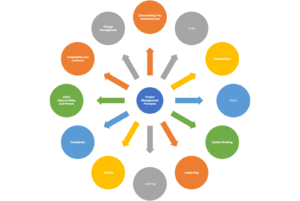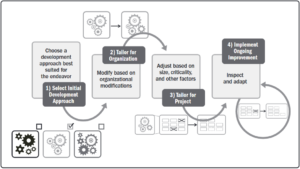7 Best Practices to Implement Resource Planning in the Audit and Accounting Industry
A Statista survey reveals that the estimated revenue of the accounting industry will grow to $145 billion.
The growth in the audit and accounting industry can be attributed to various factors, including increased demand for advisory services, the growing complexity of tax regulations, a rise in financial fraud, and ongoing technological advancements. As a result, there’s an increasing necessity for audit and accounting services as companies worldwide aim to safeguard their profit margins and retain a competitive edge.
Nevertheless, these firms encounter several workforce-related challenges, such as a scarcity of skilled consultants, suboptimal resource utilization, burnout, etc. Hence, it becomes crucial for the audit and accounting industry to adopt an efficient resource planning process to optimize their workforce and increase profitability.
This blog encompasses the key resource planning strategies for audit and accounting firms and how SAVIOM can help.
Let’s begin.
Benefits of resource planning in the audit & accounting industry
Resources are the backbone of audit and accounting firms as they generate revenue by billing their clients for the consultant’s time and expertise. Thus, these firms need effective resource planning to maximize the billable utilization of their employees and increase ROI.
Since this industry experiences seasonal fluctuations, resource planning enables firms to meet the capacity vs. demand gap and fulfill all the project requirements. This approach also bridges the skill gaps, ensuring consultants are available before project onset, thus reducing last-minute firefighting.
Further, it helps these firms identify and assign the right consultants to the right tasks at the right time and cost and deliver top-notch projects. In addition, it also enables firms to remain competitive in a swiftly evolving market and adapt to new challenges.
Now that you understand the importance of resource planning, let’s dive into the essential techniques to implement it.
Here are the seven best ways to create an efficient resource plan in audit and accounting firms:
1. Foresee and bridge demand gaps of auditors & accountants
One of the crucial steps of resource planning is where managers forecast the capacity vs. demand gap of consultants for pipeline audit/accounting projects. It will help them analyze the resource requirements ahead of time and take proactive measures to bridge the gaps. For instance, a pipeline project needs four auditors to complete the work successfully.
If the organization has two auditors, it indicates a shortage of two resources. To bridge this gap, managers can implement training programs for junior auditors, utilize out rotation and backfill strategy, or go for planned hiring. Conversely, if they had six auditors, managers could bring forward the project timelines or sell the extra capacity. This will help eliminate the last-minute hiring of resources.
2. Allocate competent accounting personnel to projects
The audit firms often utilize niche-skilled employees like forensic accountants, IT consultants, budget analysts, etc., to deliver projects. Since these resources are expensive to procure, managers must ensure they are judiciously allocated to projects based on their skills, availability, etc., to enhance their billable utilization.
Moreover, managers can assign skilled global accounting personnel from low-cost locations per the project requirements. For example, managers can allocate a skilled junior counterpart instead of assigning a senior auditor to audit financial reports. This will help minimize resourcing costs significantly and successfully deliver projects.
Advertisement
[widget id=”custom_html-68″]
3. Build the right mix of contingent and permanent consultants
In the audit and accounting industry, the demand for consultants witnesses a surge during the financial year-end. Therefore, it is imperative to have a blend of on-demand and permanent workforce to fulfill the project demands.
For instance, an audit firm requires a senior tax analyst to prepare and submit the tax filings for a short-term project. Since the existing resources are engaged with tasks, the firm can assign a contingent employee to complete the project on time. Conversely, they can deploy a permanent tax analyst for a long-term project. This will prevent last-minute firefighting for resources, and firms can effectively meet the deadlines.
4. Establish & monitor utilization targets of professionals
Most audit and accounting firms leverage internal and external professionals to meet client requirements. Therefore, establishing and monitoring the targets will ensure the blended workforce is utilized to the maximum potential. This will help them prevent operational inefficiencies and increase billable utilization.
For instance, on-demand auditors are hired hourly for short-term projects. Therefore, their billable utilization target can be set to 100%. Meanwhile, the target for permanent auditors can be set between 80-85% to balance their time spent on billable and non-billable tasks. This way, audit firms can optimize the productive utilization of their workforce and ensure seamless project execution.
5. Allow audit & accounting staff to choose projects of their interest
As the audit and accounting personnel spend most of their time working on similar projects, they experience monotony, which leads to disengagement and lowered productivity. To avoid this, managers must allow employees to choose projects of their interest by publishing open positions.
This will enable interested professionals to apply for suitable vacancies, and accordingly, managers can choose the best-fit consultants for the projects. When consultants work on assignments of their interest, it will increase their motivation and performance and improve their career trajectory.
6. Create training and development programs as appropriate
According to a survey, 80% of finance and accounting workers say it’s vital for a company to offer training programs to keep them upskilled for the future.
Training and development programs are crucial in the audit and accounting industry as they help consultants build in-demand skills. For this, managers can formulate various upskilling programs, individual development plans (IDPs), etc.
Further, they can facilitate development initiatives like blended learning, shadowing opportunities, on-the-job training, etc. This will enable the professionals to take up multi-faceted projects, bridge existing skill gaps, and diversify their career portfolios.
7. Implement succession planning for critical roles
When consultants in critical positions retire or suddenly exit the firm, it can derail the projects, leading to client dissatisfaction. To avoid this situation, firms can implement succession planning.
For this, managers must regularly monitor professionals’ performance and determine who is eligible for the critical positions. Then, they must provide appropriate training to these resources so that they can take up strategic and leadership roles. This will enhance the consultants’ engagement and ensure project continuity.
Now that we know the steps, let’s understand how ERM software can help.
How does advanced ERM software help in effective resource planning?
Implementing Saviom’s ERM tool can enable audit and accounting firms to plan their consultants efficiently. The tool offers:
- 360-degree visibility and advanced filters enable managers to identify and assign consultants based on their skills, competencies, location, etc.
- Forecasting and capacity planning enable managers to foresee pipeline project demand and identify the shortage/excess of resources. Then, managers can take corrective measures like training, hiring, etc., to bridge the gaps.
- BI reports like forecast vs. actual, and utilization helps implement remedial measures to eliminate under/over utilization. Besides, it helps mobilize accountants from non-billable to billable or strategic tasks.
- What-if-analysis enables managers to create and compare various project scenarios and determine the best-fit resource plan.
- With the open seat feature, managers can publish open positions, and professionals can choose projects of their interest, thus improving engagement.
Final thoughts
Resource planning is essential for audit and accounting firms to maximize workforce efficiency and improve project quality. By implementing the above strategies and a futuristic resource management solution, these firms can optimally utilize the professionals and maintain profitability.











